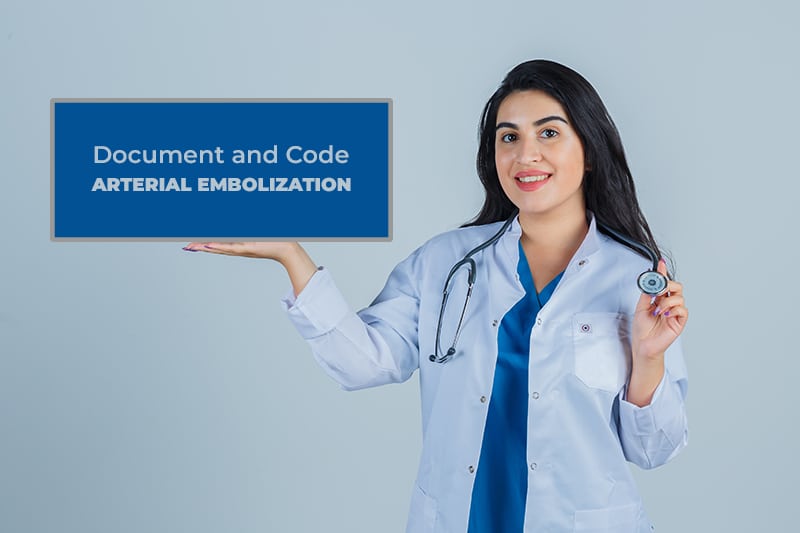Vascular surgery is performed using a traditional surgical approach and a minimally invasive catheter-based endovascular approach. Arterial embolization is a minimally-invasive procedure that blocks arterial blood flow to a tumor or an abnormal area of tissue, partially or completely. For appropriate billing and coding, vascular surgeons need to have proper knowledge of current coding and documentation guidelines. Working with an experienced provider of vascular medical coding services can ensure that every aspect of treatment is documented for appropriate billing and reimbursement.
What is Arterial Embolization?
During arterial embolization, medications or embolic agents such as synthetic materials are placed through a catheter into a blood vessel to block blood flow to the target location. Typically, the catheter is inserted in a vein in the groin area and an imaging technique ensures that the medication or embolic agent is delivered to the target site. This medical procedure is done to:
- Control or prevent abnormal bleeding
- Cut off blood supply to a tumor and shrink it
- Correct abnormal connections between veins and arteries
- Address aneurysms (a bulge at a weak point in a blood vessel wall)
- Reduce the size of tangled non-straight veins to reduce pain and swelling
Embolization is used for a variety of conditions affecting different areas of the body such as: arteriovenous malformations (AVM), brain aneurysms, cancers and tumors that cause bleeding, persistent nosebleeds, gastrointestinal bleeding (due to peptic ulcer), heavy menstrual bleeding, overactive spleen, retroperitoneal hematoma, traumatic injuries affecting the liver, lungs and other organs, uterine fibroids, vascular malformations, and varicocele.
CPT Codes for Arterial Embolization
CPT Code range 37241- 37244 describe Vascular Embolization and Occlusion Procedures on Arteries and Veins.
CPT codes 37241-37244 are Non CNS (Central Nervous System) and Non Head/Neck. Here are the clinical indications and guidelines for using these codes:
37241 Vascular embolization or occlusion, inclusive of all radiological supervision and interpretation, intraprocedural roadmapping, and imaging guidance necessary to complete the intervention; venous, other than hemorrhage (eg, congenital or acquired venous malformations, venous and capillary hemangiomas, varices, varicoceles)
Code 37241 is appropriate for the following clinical indications:
- Embolization/sclerotherapy of gastric or esophageal varices
- Varicoceles
- Incompetent ovarian veins
- Venous or lymphatic malformations
Do not assign 37241 for extremity incompetent veins or spider veins or for embolization of accessory (side) branches of an AV dialysis graft.
37242 Vascular embolization or occlusion, inclusive of all radiological supervision and interpretation, intraprocedural roadmapping, and imaging guidance necessary to complete the intervention; arterial, other than hemorrhage or tumor (eg, congenital or acquired arterial malformations, arteriovenous malformations, arteriovenous fistulas, aneurysms, pseudoaneurysms) arteriovenous fistulas, aneurysms, pseudoaneurysms)
Appropriate indications for code 37242 are:
- Arterial malformations
- AV malformations, AV fistulas
- Pre-operative fracture fixation
- Genicular artery embolization (GAE) to treat painful knee osteoarthritis
- Aneurysms
- Pseudoaneurysms
- For a diagnostic pelvic angiogram and bilateral arterial occlusion balloons placement to prevent pelvic hemorrhage, report 37242 once with modifier -52 (reduced services) along with 75736-50 (bilateral pelvic angiogram) and the appropriate catheter placement codes. Document the findings and medical necessity of the diagnostic angiogram.
- 37242 can be used to report non-target vessel embolization of an inferior mesenteric artery (IMA), internal iliac, or accessory renal at the same session as an endovascular aneurysm repair (EVAR) or iliac aneurysm endograft repair.
- If permanent embolization becomes necessary, then CPT code 37242 is used without modifier -52.
- Do not use code 37242 for the embolization of the at-risk vessels as they are part of the same surgical field.
37243 Vascular embolization or occlusion, inclusive of all radiological supervision and interpretation, intraprocedural roadmapping, and imaging guidance necessary to complete the intervention; for tumors, organ ischemia, or infarction
Immediately prior to chemoembolization, the surgeon may embolize other vessels (e.g. gastroduodenal artery) that are at risk of being occluded during the chemoembolization. Code 37243 is used to report the embolization portion (tumor embolization) of a chemoembolization procedure. Common applications for 37243 include:
- Renal infarction for severe proteinuria, benign prostatic hypertrophy (BPH)
- Renal cell carcinoma
- Uterine fibroids
- Benign/malignant vascular neoplasms/tumors
- Hepatic or osseous metastasis
- Splenic hypertrophy
- Direct needle access into head and neck tumors (e.g., carotid body tumor, glomus tumor).
- Selective portal vein embolization pre-operatively to shrink a lobe of the liver that contains a tumor
- Assign only code 37243 for the tumor embolization
- Do not assign code 37242 for the embolization of the at-risk vessels, since they are part of the same surgical field
- Catheterization of the at-risk vessels should be coded separately
- Code 37243 includes radiological supervision and interpretation, guidance and roadmapping
In cases where the interventional physician determines the chemotherapy dose, writes the prescription, and personally administers the chemotherapeutic agent in conjunction with the embolic agent, procedure code 96420, Chemotherapy administration, intra-arterial; push technique, may be assigned in addition to the embolization codes. However, Medicare will not pay physicians for code 96420 in the hospital setting (in the Medicare Physician Fee Schedule, meaning that it is considered a staff service rather than a physician service) (Radiology Today).
37244 Vascular embolization or occlusion, inclusive of all radiological supervision and interpretation, intraprocedural roadmapping, and imaging guidance necessary to complete the intervention; for arterial or venous hemorrhage or lymphatic extravasation
Code 37244 last code is for treating the following:
- Trauma
- Thoracic duct leak
- hemorrhage or lymphatic extravasation, such as gastrointestinal bleeds
- Traumatic hemorrhage of the viscera or pelvis
- Bronchial embolization for treatment of hemoptysis
37244 can be used with modifier 52 for a temporary balloon inflation performed during a high-risk surgical procedure to control or treat an active hemorrhage.
General Guidelines for Using Arterial Embolization Codes
- Codes include supervision and interpretation, road-mapping and imaging required to complete the procedure.
- Embolization codes 37241–37244 may only be reported once per surgical field, regardless of the number of vessels that are occluded. The CPT manual defines the surgical field as “the area immediately surrounding and directly involved in a treatment/procedure.”
- Selective catheter placements and diagnostic angiography should be reported separately.
- Code the main reason for performing the embolization.
- If bilateral embolizations are performed in separate surgical fields, the second embolization should be reported with modifier XS (Separate structure), 76, or 59, or as instructed by the payer.
<h3=”ICD-10 Codes for Peripheral Embolization”>ICD-10 Codes for Peripheral Embolization
Diagnosis codes for peripheral embolization as listed by Medtronic include:
Liver cancer
C22.0 – Liver cell carcinoma (hepatocellular carcinoma)
C22.1 Intrahepatic bile duct carcinoma (cholangiocarcinoma)
C78.7 Secondary malignant neoplasm of liver and intrahepatic bile duct
C7B.02 Secondary carcinoid tumors of liver
Varicocele – I86.1 Scrotal varices
Uterine fibroids – D25.0 – D25.9 Leiomyoma of uterus
Pelvic congestion syndrome – I86.2 Pelvic varices
AAA Endoleak (Type II) I97.89 – Other postprocedural complications and disorders of the circulatory system, not elsewhere classified
Abdominal aortic aneurysm I71.40 — I71.43 Abdominal aortic aneurysm, without rupture
Arteriovenous malformation, pulmonary Q25.72 Congenital pulmonary arteriovenous malformation
Arteriovenous malformation, Q27.39 Arteriovenous malformation, other site (congenital)
uterine
I77.0 Arteriovenous fistula, acquired Arteriovenous malformation,
renal
Q27.34 Arteriovenous malformation of renal vessel (congenital) Aneurysm, peripheral I72.2 Aneurysm of renal artery
I72.3 Aneurysm of iliac artery
I72.8 Aneurysm of other specified arteries (e.g., SMA, splenic, celiac, hepatic)
Clear and detailed documentation is essential for successful claim submission. A medical billing company that specializes in vascular medical billing and coding can help providers report services provided correctly for appropriate reimbursement.




